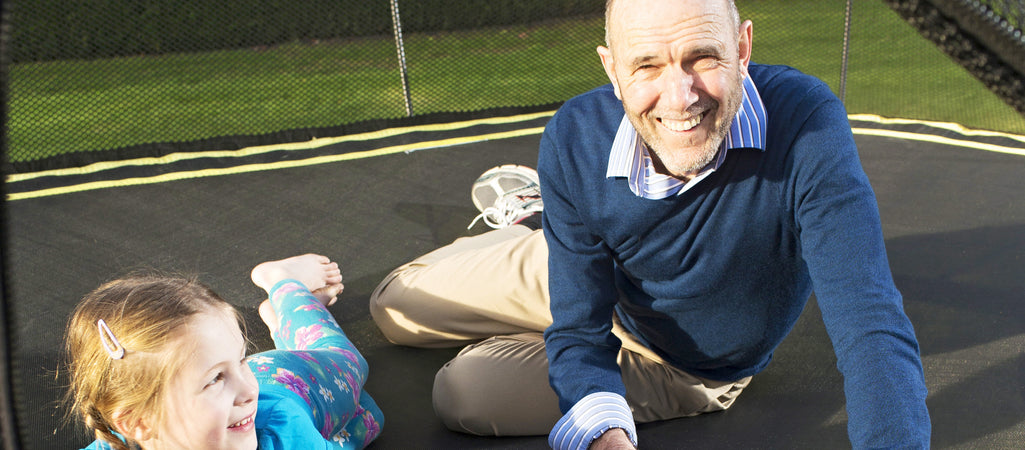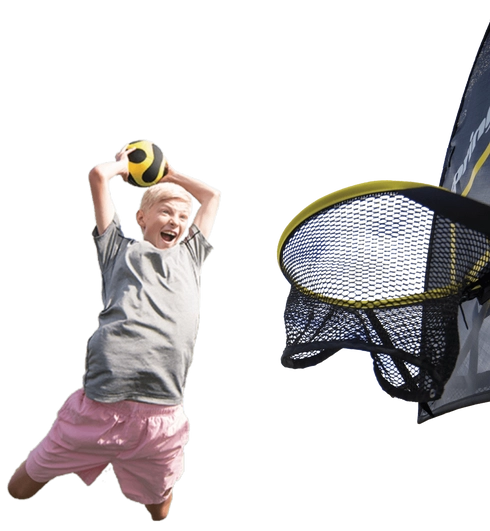Conversations with... Dr Keith Alexander
min read

Over 15 years ago, a Kiwi father of three decided a trampoline would be a good addition to the family backyard. However, after researching traditional designed trampolines for his family it was abundantly clear that they were incredibly dangerous and shockingly, no manufacturers seemed to seriously consider the safety of their products.
And so began Dr Keith Alexander’s journey to create a safe trampoline. After 14 years of design and prototype revisions, this dedicated inventor finally landed on the design that has made Springfree Trampoline the World’s Safest Trampoline.
Dr Alexander kindly took some time out of his day to share a bit more of his story and a provide us a little insight into the life of an inventor.
1. We’re curious to learn how you discovered (and why you chose) the trampoline to reinvent, and what was your journey leading up to this decision?
When I wanted a trampoline for my young daughter, my wife Faith started me off by saying trampolines were too dangerous. I decided as an engineer I should be able to do something about this. I tried a number of designs (below), with help from university students and my children, who became the trampoline testers. Eventually an investor from Canada was found who would manufacture it.
Inflatable: good for small children, not very bouncy, always leaked, far too expensive
Springs in Ring Underneath: Soft edge but very poor bounce and twice as many springs. Too expensive.
Rod Trampoline: Soft edge, good bounce, novel technology, hi-tech materials, looked good, great net.
2. What about Springfree, do you think, makes it such a standout among other trampolines?
- A new concept, redesigned from the ground up to be safer, and last longer.
- The design needs no pads because the edge itself is resilient.
- The edge stiffness is much softer than a traditional steel tube edge covered by a safety pad.
- The resilient edge is an integral part of the trampoline so it cannot come off or deteriorate like traditional pads can.
- The frame is well below the mat where the jumper cannot come into contact with it.
- Any design change in the frame is tested to 3 million bounce cycles.
- The net is flexible, and the poles supporting it are flexible so that they cannot become a significant source of injury.
- The flexible net is designed as another play surface. Nets on traditional trampolines are only there for safety and are not built to be a play surface.
- The net material is UV resistant, so it will typically last the life of the trampoline.
- The net fabric will not run, so even with small holes, the net remains effective.
- All Springfree trampolines are sold with the net as an integral part of the trampoline – the net is not something that is optional, so it is always there.
- The Springfree trampolines have a ten year warranty on all parts, so remain safe for their useful life.
- Because they are built to last, they keep their value and are often sold second hand.
- It is the only backyard trampoline which has had research to show how much of a safer product it is than the traditional designs. (Ref 1)
View more in-depth explanations on the unique features of the Springfree Trampoline, from Keith, in the YouTube playlist 'Inventor Knows Best'
3. The Springfree Trampoline is a good looking trampoline! Tell us about the creative process that led to the final design and what inspiration you drew from to get to the final product?
As shown above, the eventual design was the 3rd concept of many that was taken to a full scale trampoline prototype. What was needed was a design that did away with the features that were causing injury – hard impact surfaces. Initially I just guessed that the hard steel edge had to be a big problem, if not the biggest, so my initial designs tried to solve that. After trying steel bars to substitute for springs I was steered to pultruded fibreglass. This is a high tech material that is uniquely suitable to act like springs, and is what makes the characteristic sides of the Springfree trampolines. Then there was a requirement for a net. At first I just copied the steel pole design others were using, but I was told we had to use fibreglass rods the same as in the trampoline edge, but longer. I did not believe that would work – I believed it would be too flexible. But when we built one and the kids started bouncing off the walls, we realised it was another play surface, and unique to our product. Another development path was the mat rod holder. This plastic component went through 7 versions (below) before settling on the one we have now.
Each of the above needed a CAD model, 3-D printed model and a Die built for Plastic Injection Moulding, and then 100 or so had to be made to test on a trampoline. Needless to say there were good reasons for abandoning each one in this figure.
4. Quality is very important to Springfree. Can you tell us about the manufacturing process behind your products and what is important to you?
Key quality decisions were:
- The new technology had to work seamlessly or the market would not accept it as a realistic alternative to traditional designs.
- This meant the rods had to perform at least as well as springs, and this has been achieved.
- To sell on safety meant that this new design could not afford to add new risks, so risks were designed out or managed by good quality control.
- Good quality control means batches of components have to be labelled for tracking; rods and frames have serial number tracking.
- Getting longevity means fabric and plastic materials must have ultra-violet protection built in. This also has to be tracked.
- Verification that fabrics have UV protection requires testing to be done on all batches of fabric used in the factory. This testing is done both in China, and backed up by parallel testing in New Zealand. Batches of fabrics received by the factory are quarantined until these tests confirm their integrity.
- Any design change in the frame is tested to 3 million bounce cycles. No other manufacturer does this.
- The design is such that the product complies with American, European and Australian standards for trampoline safety.
- There is a large number of tests done throughout the design and manufacturing process, that are too numerous to mention.
What is important to me is that this trampoline is as safe as it could be. The design from the ground up is consequently safer because of many of the reasons touched on in question two.
5. Have you ever wondered what else you might’ve put your hand to transforming if you didn’t take on the trampoline? If so, what do you think you would’ve done?
It’s not quite like that: My real job is teaching engineering students and supervising engineering postgraduate students. This means I am involved with all sorts of projects on a daily basis. The Springfree project was a strong focus 1996 through to 2005 when it was in the market. If I hadn’t done the trampoline I would probably have written more research papers and taken some other product to market – which could have been one of a number in the university environment.
6. Have you worked on other smaller inventions, along the way, that haven’t made the global stage in the same way Springfree has?
Yes. I think you’ll find that anyone who has had a product go to market, will also have a number that have failed. That is an important part of the education of inventors and entrepreneurs.
7. There have been many milestones for you on this journey. What are some of the highs and lows behind the milestones, what are a couple of stand-out memories and lessons?
Highs:
- I am awed at how well the factory in China is being run; It is hard to grasp that an idea I had has led to 200 people in China taking part in some of the best management principles the world has to offer.
- I am as surprised as Springfree that COVID-19 has resulted in huge demand for trampolines and allowed Springfree to increase sales and customer awareness in all markets
- It always gives me a buzz to see a Springfree Trampoline in a backyard somewhere unexpected – I recently had a photo sent to me of a Springfree Trampoline 400 miles north of the Arctic Circle in Alaska
Lows:
- There was a time early on when one of the plastic mat-rod-holder designs just wasn’t working and I felt really stupid putting so much time and money into something I was not sure would even work. Fortunately the die maker was insistent it was worth continuing. I was encouraged by that, but probably he just wanted me to keep on getting him to build dies – at $700 each…
- There was the patent defence in Washington in 2014 that was very time consuming and quite intimidating to prepare for and that led to a very ambivalent judgement. I learned to look at it as a privilege to have a patent of mine defended in Washington DC.
8. How would you like to hear customers describe Springfree Trampoline, as a company or product, in just a handful of words?
I’m delighted to hear some of the thank-you’s that come through from customers who have been grateful for the service they have received - especially from installers who are often the only Springfree person that the customer meets, right there in their own back yard.
I’m very satisfied that a large proportion of Springfree sales come about by word of mouth. I’m not sure what customers say to each other, but their words have more credibility than mine.
9. You are still involved with Springfree Trampoline on a smaller scale, so what else do you put your hand to, these days?
My real job is teaching engineering students and supervising engineering postgraduate students. This means I am involved with all sorts of projects on a daily basis.
10. Tell us about your ideal day off?
That depends a bit on what has been going on, but recently with lock down and working from home – most of the day is on the computer, so it’s good to just get into the workshop and make things.
11. Finally, when the restriction levels are lowered, are you planning to get away and if so, where will you escape to?
We once went to Rarotonga and snorkeled around the reef. That’s what comes to mind before all the practicalities come tumbling in!
Other Articles You May Enjoy
Refs:
- Eager, D., Scarrott, C., Nixon, J., Alexander, K.V. “Survey of Injury Sources for a trampoline with equipment hazards designed out” Journal of Paediatrics and Child Health, 2012 Jul;48(7):577-81. doi: 10.1111/j.1440-1754.2012 .02426.x. Epub 2012 Mar


